Introduction
Welcome to Teaching Through Documentary Art: Lessons for Elementary and Middle School Social Studies Teachers.
Why Documentary Art in the Classroom?
About These Lessons
How to Use These Lessons
Why Learn About Davis Bottom?
The Significance of the July 4th, 1867 Event and Its Link to Davis Bottom
Related Educational Resources
Credits and Acknowledgements
Why Documentary Art in the Classroom?
Documentary art is created to represent lifestyles or events of the past, provoke lively discussions, and generate questions. Teachers can use discussion of images to build visual literacy, critical thinking, collaboration, and communication skills. These are key components of 21st Century Skills and are also embedded in the Kentucky Academic Standards/Common Core Standards in English Language Arts; and the Kentucky Academic Standards in Arts and Humanities/National Core Arts Standards.
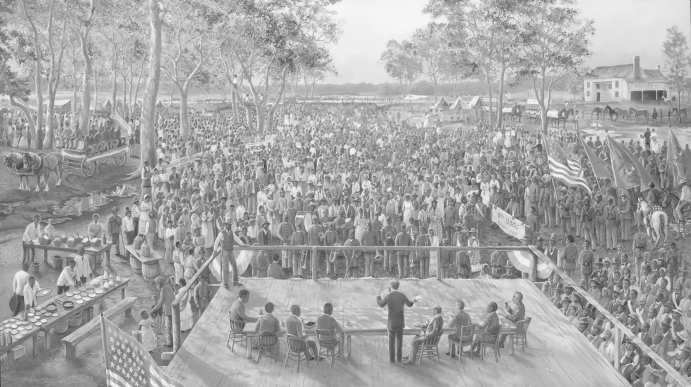
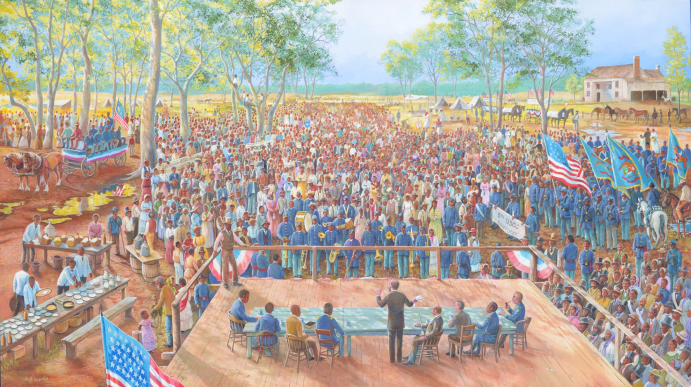
About These Lessons
The curriculum materials in Teaching Through Documentary Art are linked to two documentary murals created by Susan A. Walton to fill visual voids in the Davis Bottom History Preservation Project’s award-winning documentary film, Davis Bottom, Rare History, Valuable Lives. Walton’s artwork draws from primary source archival and historic documents research: published historic sources, original historic research, archival photographs, period documents, contemporary photographs, and contemporary oral histories. Both murals visually document the progression of civil rights in Kentucky in the aftermath of the Civil War.
The first painting, Davis Bottom in the 1890s, creates a portrait of Davis Bottom at the turn of the last century. Davis Bottom, a working class neighborhood in Lexington, Kentucky, was one of the city’s first integrated neighborhoods.

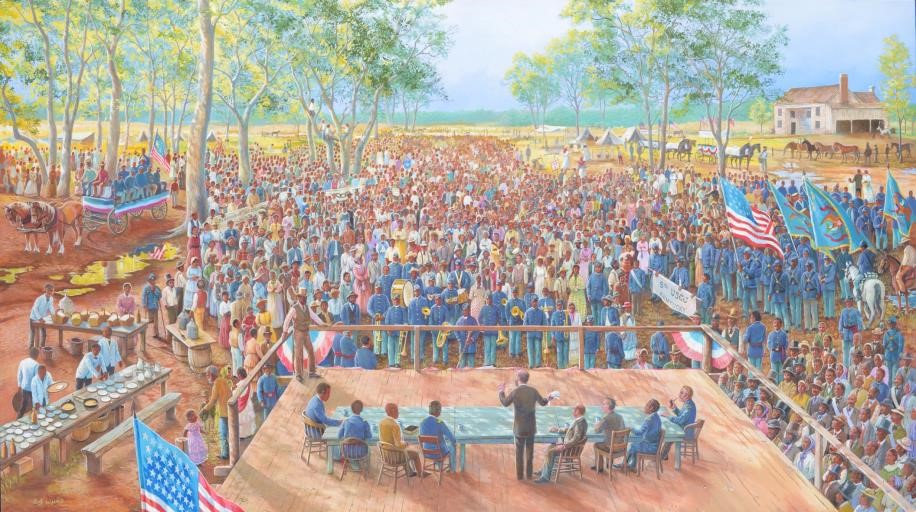
The second, Civil Rights in Lexington – 4th of July 1867, recreates the scene of one of Kentucky’s largest civil rights events, held on July 4, 1867, just outside Lexington. Its link to Davis Bottom? William “Willard” Davis, the man responsible for establishing Davis Bottom as an integrated community, was among the speakers that day.
These six lesson sets linked to the first painting, target upper elementary school students (grades 4-5) but easily can be adapted for middle school. Learning about the lives of the late 20th century working class people of Davis Bottom gives students the opportunity to explore the meaning of neighborhood and the definition of family, the use and abuse of power, and stereotypes about the working poor.
Civil Rights in Lexington – 4th of July 1867
These five lesson sets linked to the second painting, target middle school students (grades 6-8) but can be adapted for high school. Learning about this event helps students understand the situation of newly freed African Americans after the Civil War and the beginnings of their long struggle for civil rights.
The curriculum materials in Teaching Through Documentary Art are aligned to the Kentucky Core Academic Standards/the C3 Framework for Social Studies State Standards; the Kentucky Academic Standards/Common Core Standards in English Language Arts; and the Kentucky Academic Standards in Arts and Humanities/National Core Arts Standards.
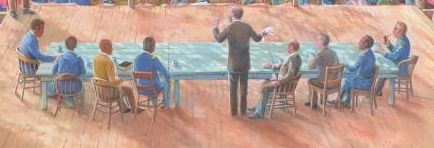
How to Use These Lessons
Educators can use the lessons in Teaching Through Documentary Art alone or in combination with content accessible through the Davis Bottom History Preservation Project website and the video documentary Davis Bottom, Rare History, Valuable Lives. Davis Bottom in the 1890s also can be used in conjunction with Investigating a Shotgun House, a unit in Project Archaeology’s Project Archaeology: Investigating Shelter Series, available for purchase and download at (http://projectarchaeology.org/teachers).
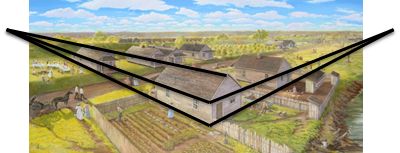 Each Teaching Through Documentary Art lesson set begins with a short, illustrated, grade-level background essay. Background essays are accessible on-line, or .pdf versions can be downloaded and distributed. Essays are followed by standards-based Discussion Questions and a list of Achieved Standards. Teaching Tips, which provide suggestions for teaching and activities, round out each lesson set. Discussion Questions, Achieved Standards, and Teaching Tips are provided in downloadable .pdf format for teachers. Words italicized in the essays are new vocabulary words, and are either defined in the essay or listed in Teaching Tips for definition and classroom discussion. The activities connect social studies content based on the Kentucky Core Academic Standards/the C3 Framework for Social Studies State Standards with standards from the Kentucky Academic Standards/Common Core Standards in English Language Arts; and the Kentucky Academic Standards in Arts and Humanities/National Core Arts Standards.
Each Teaching Through Documentary Art lesson set begins with a short, illustrated, grade-level background essay. Background essays are accessible on-line, or .pdf versions can be downloaded and distributed. Essays are followed by standards-based Discussion Questions and a list of Achieved Standards. Teaching Tips, which provide suggestions for teaching and activities, round out each lesson set. Discussion Questions, Achieved Standards, and Teaching Tips are provided in downloadable .pdf format for teachers. Words italicized in the essays are new vocabulary words, and are either defined in the essay or listed in Teaching Tips for definition and classroom discussion. The activities connect social studies content based on the Kentucky Core Academic Standards/the C3 Framework for Social Studies State Standards with standards from the Kentucky Academic Standards/Common Core Standards in English Language Arts; and the Kentucky Academic Standards in Arts and Humanities/National Core Arts Standards.
To use Davis Bottom in the 1890s on its own, begin with Lesson Set 1: Davis Bottom in the 1890s. The background essay and activities invite students’ exploration of the painting as a whole and include writing poetry and analyzing the artist’s use of the elements of art. To access the other five lesson sets, linked to six vignettes – small illustrations – that are part of the larger Davis Bottom in the 1890s painting, use your mouse to roll over the painting to access the vignette, or use the links below. From left to right, and from top to bottom, these vignettes are:
 Lesson Set 2: Attending a Fish Fry – focuses on community traditions and includes directions for a self-contained special writing project that guides students in exploring their own community’s traditions and writing about them.
Lesson Set 2: Attending a Fish Fry – focuses on community traditions and includes directions for a self-contained special writing project that guides students in exploring their own community’s traditions and writing about them.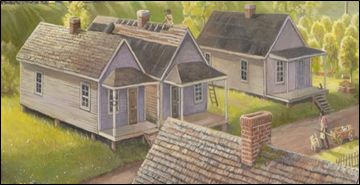
- Lesson Set 3: Building a Shotgun House – focuses on the most common type of house in the neighborhood and includes links to art activities that illustrate students’ own homes and shelters of diverse cultures. There is also a poetry-writing activity and a lesson on roof technology.
- Lesson Set 4: Growing Up in Davis Bottom – focuses on the lives of children during this era and invites comparisons to the lives of children today. It also explores primary and secondary historic resources.
- Lesson Set 5: Making a Living – focuses on adults’ occupations and includes an interactive lesson with census data.
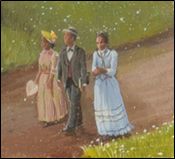 Lesson Set 6: Meeting the Hathaway Family – introduces the Robert Hathaway family and Isaac Scott Hathaway, who grew up in Davis Bottom and became one of the most
Lesson Set 6: Meeting the Hathaway Family – introduces the Robert Hathaway family and Isaac Scott Hathaway, who grew up in Davis Bottom and became one of the most  influential African American sculptors of the 20th century. Art and writing activities and a link to an audio biography of the artist are included.
influential African American sculptors of the 20th century. Art and writing activities and a link to an audio biography of the artist are included.
To use Civil Rights in Lexington – 4th of July, 1867 on its own, begin with Lesson Set 1: Civil Rights in Lexington – 4th of July, 1867. The background essay and activities invite students’ exploration of the whole painting and include writing poetry and analyzing the artist’s use of the elements of art. To access the additional four lesson sets linked to four vignettes – small illustrations – that are part of the larger the 4th of July, 1867 painting, use your mouse to roll over the painting to access the vignette, or use the links below. From left to right, and from top to bottom, these vignettes are:
 Lesson Set 2: Civil War Veterans – focuses on veterans and in particular, issues of African American veterans of the Civil War. It includes links to
Lesson Set 2: Civil War Veterans – focuses on veterans and in particular, issues of African American veterans of the Civil War. It includes links to  oral histories and the African American Civil War Soldiers Monument in Frankfort.
oral histories and the African American Civil War Soldiers Monument in Frankfort.- Lesson Set 3: United States Colored Troops – focuses on the complex situation in Kentucky during the Civil War, the role of African American soldiers, and the plight of their families. It includes research opportunities.
- Lesson Set 4: Meet The Band – focuses on the essential role of music in the military and the music and instruments of the Civil War era. It includes research opportunities.
- Lesson Set 5: Meeting the Speakers on the Platform – focuses on the issues of voting and civil rights and the role of individual abolitionists after the Civil War. It includes research opportunities.
Why Learn About Davis Bottom?
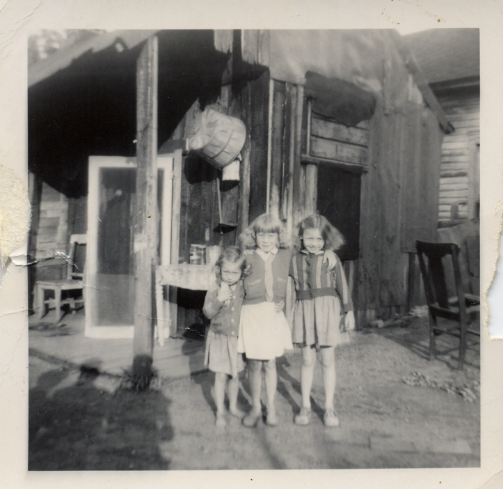 Davis Bottom in Lexington, Kentucky, was one of the most impoverished neighborhoods in Fayette County. It also was one of Lexington’s first integrated communities after the Civil War. Despite economic hardships, residents made the tight-knit enclave a safe, strong, and racially diverse community for almost one hundred and fifty years.
Davis Bottom in Lexington, Kentucky, was one of the most impoverished neighborhoods in Fayette County. It also was one of Lexington’s first integrated communities after the Civil War. Despite economic hardships, residents made the tight-knit enclave a safe, strong, and racially diverse community for almost one hundred and fifty years.
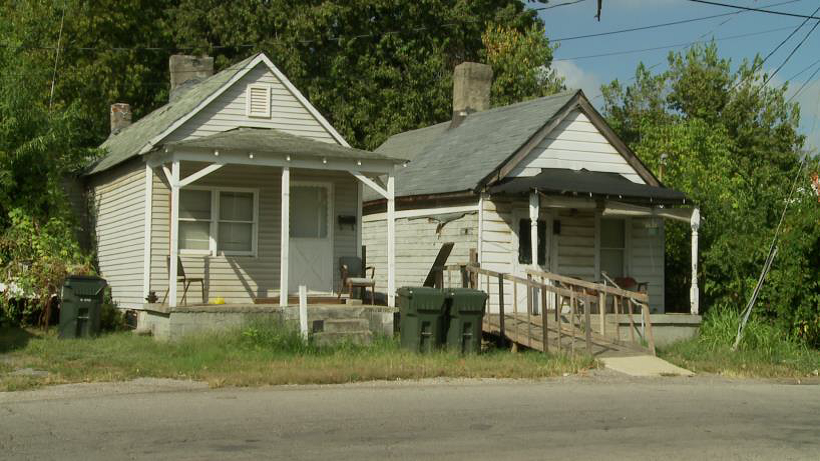 After decades of political and legal battles, in 2010, construction of a new road – Newtown Pike Extension – through the heart of the Davis Bottom neighborhood and neighborhood redevelopment transformed Davis Bottom’s dilapidated dwellings and industrial buildings into Davis Park.
After decades of political and legal battles, in 2010, construction of a new road – Newtown Pike Extension – through the heart of the Davis Bottom neighborhood and neighborhood redevelopment transformed Davis Bottom’s dilapidated dwellings and industrial buildings into Davis Park.
To reduce the impact of road construction and neighborhood redevelopment, residents, community leaders, and government officials developed several programs designed to retain “community cohesion.” This included the purchase of temporary homes (mobile homes on-site) - while the City built new houses, apartments, and townhouses - and the creation of the Lexington Community Land Trust, a neighborhood organization trusted with keeping housing affordable in the new neighborhood by protecting land values from market forces (http://www.lexingtonclt.org/). Scholars also worked with residents to preserve the history of Davis Bottom. Production of the hour-long documentary, Davis Bottom: Rare History, Valuable Lives, was an important part of their work.
The Significance of the July 4th, 1867 Event and Its Link to Davis Bottom
The Thirteenth Amendment, passed by the U.S. Congress in 1865, abolished slavery, but it did not protect the civil rights of blacks. Some states passed laws that said African Americans could not buy property or testify in court. The Civil Rights Act of 1866, passed on April 5, 1866, said that people born in the United 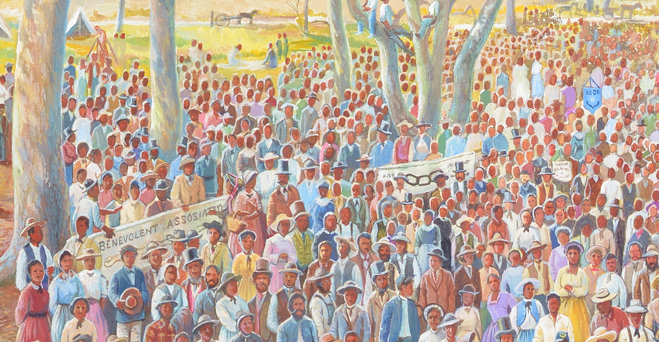 States were entitled to be citizens, without regard to race, color, or previous condition of slavery. It also said that any citizen had the same right that a white citizen had to buy or rent property and to give evidence in court. Some states had state laws that limited these rights. Kentucky, for example, had laws that prohibited blacks from voting and from testifying in state
States were entitled to be citizens, without regard to race, color, or previous condition of slavery. It also said that any citizen had the same right that a white citizen had to buy or rent property and to give evidence in court. Some states had state laws that limited these rights. Kentucky, for example, had laws that prohibited blacks from voting and from testifying in state court cases “where a white person is a party concerned.”
On July 4, 1867, a crowd of between six and ten thousand people, mostly African Americans, gathered for a parade through the streets of downtown Lexington. They marched to a wooded area off Harrodsburg Pike (now Road) about a mile southwest of 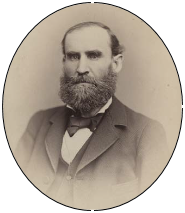 Lexington. The crowd stayed for a peaceful day of picnics, music and speeches about civil rights. It was one of the largest events for civil rights in the history of Kentucky.
Lexington. The crowd stayed for a peaceful day of picnics, music and speeches about civil rights. It was one of the largest events for civil rights in the history of Kentucky.
On the speakers platform that day was William “Willard” Davis (shown at left), a young Lexington attorney who was the man responsible for establishing Davis Bottom as an integrated community. That day, he spoke strongly in favor of civil rights and equality, and against Kentucky state laws that denied African Americans their rights.
Related Educational Resources
 The Davis Bottom, Rare History, Valuable Lives documentary is Episode 6 in the Kentucky Archaeological Survey’s video documentary series Kentucky Archaeology and Heritage Series. CD’s of this documentary and others in the series are available for purchase. You can access descriptions of all six episodes and the order form here: (http://heritage.ky.gov/kas/pubsvids/archseries.htm). Contact the Education Coordinator at the Kentucky Archaeological Survey with any questions about ordering.
The Davis Bottom, Rare History, Valuable Lives documentary is Episode 6 in the Kentucky Archaeological Survey’s video documentary series Kentucky Archaeology and Heritage Series. CD’s of this documentary and others in the series are available for purchase. You can access descriptions of all six episodes and the order form here: (http://heritage.ky.gov/kas/pubsvids/archseries.htm). Contact the Education Coordinator at the Kentucky Archaeological Survey with any questions about ordering.
Lessons about an African American community outside Louisville, The East End Bridge Project and the Story of Harrods Creek, Kentucky, also incorporate documentary art in the study of civil rights and African American communities in Kentucky. All activities (four for grades 4-5, and one for grade 8) are aligned to the Kentucky Core Academic Standards/the C3 Framework for Social Studies State Standards and the Kentucky Academic Standards/Common Core Standards in English Language Arts. These lessons were developed by Judy Sizemore for the C. D. Smith Company, Lexington, and funded by the Kentucky Transportation Cabinet as part of the Louisville-Southern Indiana Ohio River Bridges Project’s African American Heritage Interpretive Plan.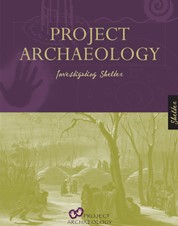
A related curriculum is Project Archaeology: Investigating Shelter. Its inquiry-based approach emphasizes archaeological questions, sources, and investigatory techniques to support a preservation ethic. It focuses on the mastery of six enduring understandings through the topical theme of shelter, a basic human need that transcends all culture. Shelter case studies are accessible from an on-line shelter database through a password in the printed guide.
“Investigating a Shotgun House,” which considers shelter in the urban, working class Davis Bottom community, is Case Study 12 in this curriculum. Links to the relevant lesson sets in Teaching Through Documentary Art are provided within that case study.
Credits and Acknowledgements
Funding for lesson development was provided by the Kentucky Transportation Cabinet to the Kentucky Archaeological Survey, which is jointly administered by 
 the Kentucky Heritage Council and the University of Kentucky’s (UK) Department of Anthropology.
the Kentucky Heritage Council and the University of Kentucky’s (UK) Department of Anthropology.
These lessons were developed in 2015 by Judy Sizemore, Education Consultant with the Kentucky Archaeological Survey and edited by A. Gwynn Henderson, Education Coordinator with the Kentucky Archaeological Survey.
Tera Warren and Pam Clay-Young of the Kentucky Transportation Cabinet transcribed the speech William “Willard” Davis gave on July 4, 1867 and which was published four days later in the Cincinnati Commercial. A. Gwynn Henderson prepared the margin notes.
The authors would like to thank Susan Walton for creating these wonderful murals. Thanks also go to Tom Law of Voyageur Media Group, Inc., and to W. Stephen McBride of Camp Nelson Civil War Heritage Park, who provided editorial comments on lesson content.
Scott Horn of the UK Arts & Sciences Hive directed the creation of these webpages. Anton Vinogradov, UK senior in computer science, developed the pages; Will Hieronymus, UK senior in integrated strategic communication, designed them; and Dakota Amiot, UK senior in computer science, managed the content.
